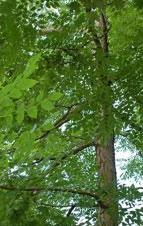|
Wed. Oct. 26: Learn about urban forestry in Onondaga County
 Stephen Harris, City-County Arborist, will speak at May Memorial (3800 E. Genesee St., Syracuse) on Wed. Oct. 26 at 7:30 pm. Stephen Harris, City-County Arborist, will speak at May Memorial (3800 E. Genesee St., Syracuse) on Wed. Oct. 26 at 7:30 pm.
Hear about the benefits of urban forests, and about the only court-ordered green infrastructure program in the U. S. It's right here in Onondaga County, and the whole country is watching! |
 Plant trees: the original green infrastructure
From ESF's E-newsletter (using info from Arbor Day Foundation):
E-Query: How do trees help with stormwater runoff?
Answer: Trees are the original green infrastructure.
Trees intercept rain and retain some on their leaves and bark, a portion of which will evaporate and the remainder will be released gradually into the soil.
Fallen tree leaves also help retain moisture in the soil by creating a layer that rain water can percolate through, instead of becoming runoff.
Additionally, trees absorb water through their roots and eventually release it into the atmosphere by transpiration.
Trees can be used in vegetative swales (i.e. channels with a dense stand of vegetation) to promote water infiltration, reduce the velocity of stormwater runoff and trap particulate pollutants. |
|
The Hidden Beauty of Pollination
 | | Dew-covered bee |
Give yourself a 4-minute gift by viewing Louie Schwartzberg's exquisite "The hidden beauty of pollination" video.
The video only is available on YouTube, but also as a TED talk, which includes a 3-minute introduction by the cinematographer. |
 | | Robin in pagoda dogwood |
Research shows home landscaping is good for birds and people, too
The results of this research won't surprise habitat gardeners, but it's nice to see that research validates what we've seen in our yards.
Their findings:
1) Native plantings increase the diversity of birds found.
2) Naturally-landscaped yards make both you and your neighbors happier.
3) They create more effective wildlife corridors and networks in developed areas.
4) Native ornamentals attract 15 times the number of species that non-native ornamentals do, including yummy caterpillars for birds to eat. (This is the research of Douglas Tallamy, the author of Bringing Nature Home.)
Here's the whole article from the Project FeederWatch blog. |
 | |
Goldfinches
|
Time for Project FeederWatch
"Embrace the winter. Count feeder birds for science." So says The Cornell Lab of Ornithology.
One of the oldest citizen science projects, PFW's 25th season is about to begin on November 12. It continues to early April.
And why has it been so popular for so many years? Because it's easy to do, fascinating, and a satisfying way to contribute to bird conservation. Once people become FeederWatchers, they have a good reason to look forward to winter each year!
You don't have to be a bird expert or spend hours watching your feeders or even be expert at bird identification. [Editor: I first became a FeederWatcher and learned to identify birds as I went along, with the help of bird ID books and FeederWatcher online resources.]
* Here's more information about PFW.
* Here's an instructional video about how to be a FeederWatcher.
|